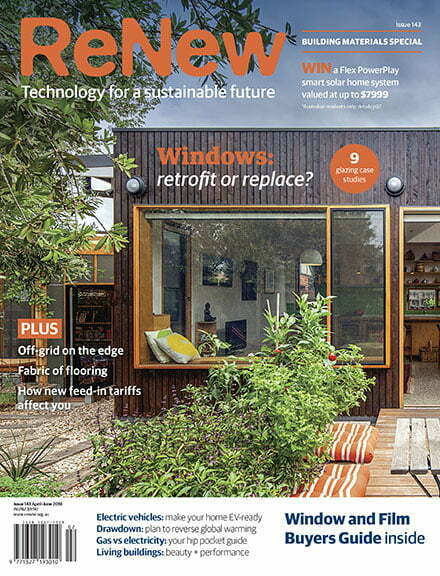The EVs are coming! But is your home EV-ready?

Electrical contractor, EV charging point installer and EV owner Bryce Gaton looks at what you need to know to assess the potential hidden installation costs and practical considerations in preparing your home for an EV.
This article was first published in Issue 143 (Apr-June 2018) of Renew magazine.
Affordable electric vehicles (EVs) with a range of 300+ kilometres are about to hit the showrooms (see Table 1). If this is going to be your year to make the shift to electric transport, then now is the time to assess your home’s electrics and prepare for the installation of an EV charging point, commonly called an EVSE (electric vehicle supply equipment). Here are four steps to help you prepare:
- Assess your home’s electrics for its capacity to deliver the fastest possible charging time.
- Choose your EVSE charging mode and current.
- Decide where to position the EVSE.
- Choose which EVSE to buy.
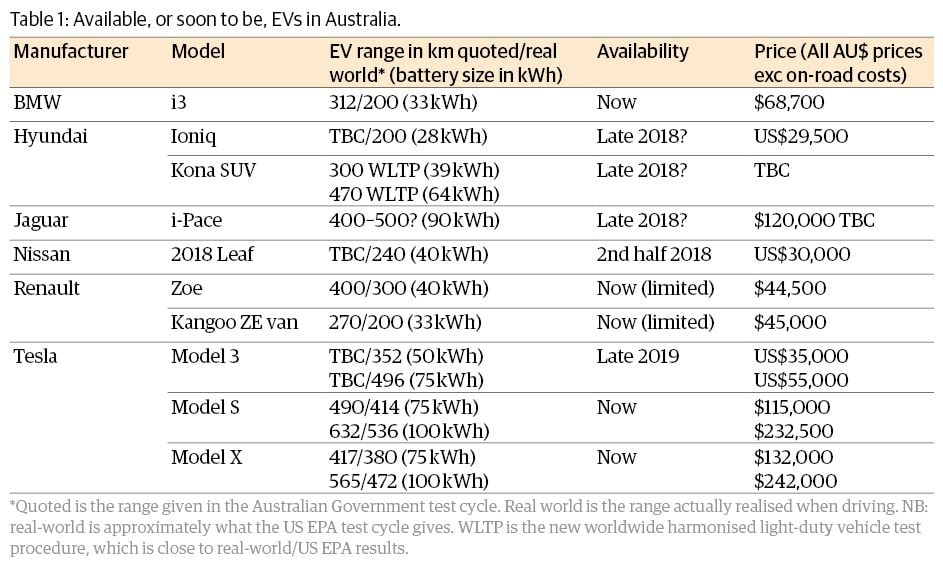
1. Assessing your home’s electrics
At one end of the spectrum, you might just need a 15 A socket outlet, with cost starting around $400 installed. At the other end, you might require a complete switchboard and supply upgrade, and full home rewiring. Costs for this can be $10,000 or more, and of course it will also entail time (possibly many months) to get the work done.
It boils down to what speed of charging you want/need and how much electrical energy your current household wiring can deliver.
First, let’s look at what the current and coming crop of EVs need if you intend to charge them as fast as you can at home. Table 2 lists the AC charging needs for all the EVs available now or coming soon to Australia.
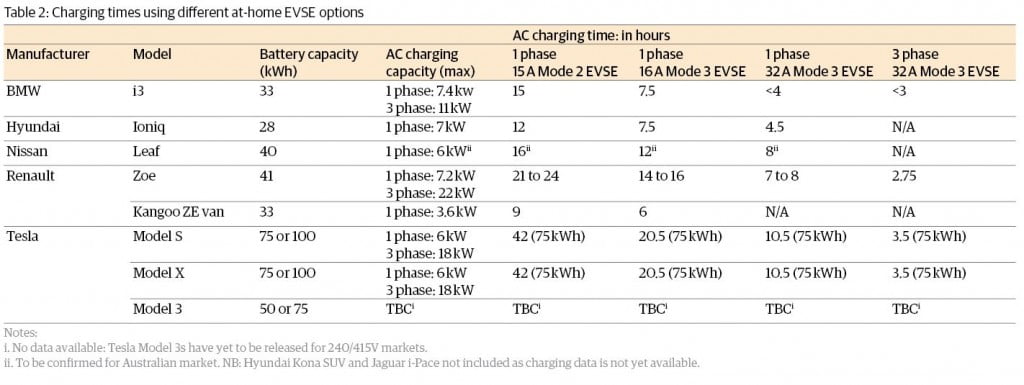
From Table 2, we can work out what additional load (in amps) the EV will add to the household use. The next step is to assess the existing wiring, incoming supply and switchboard in your home to gauge if it is likely to be able to supply this load.
To assess your home’s electrical wiring and switchboard capacity to supply an EVSE, begin with the following checklist (of course, you will still need your installing electrician to check this via a full inspection before installation):
-
Is your home less than 20 years old or has it been fully rewired in the last 20 years?
-
Does your switchboard have at least one spare slot?
-
Do you have three-phase power?
If you answered ‘Yes’ to questions 1 and 2 then you should just need to have your electrician do a maximum demand calculation to find out how much electricity you currently draw. This will tell you how much is left to supply the EVSE. Most likely, you will be able to install a 32 A capable EVSE. Your costs will most likely be only the EVSE itself plus wiring it in, with a total cost starting around $2000. Note that some manufacturers include the cost of a simple EVSE installation in the price of the car.
If you answered ‘Yes’ to question 3 as well, you have won the charging speed jackpot if buying a Zoe, Tesla or BMW i3!
You are likely to be up for additional work before the EVSE can be installed, or you may need to dial back your expectations for your EV charging speed. Here are some of the options.
If your home is less than 50 years old, the wiring should be okay (this will need to be checked), but the switchboard will need to be upgraded to allow for installing the circuit breaker for the EVSE, as your current one will have fuses rather than circuit breakers.
The approximate additional cost before installing the EVSE will be $2000 to $2500 including inspection fees. Note that you may also need to upgrade the incoming supply to the switchboard to be able to install a 32 A capable EVSE. For a simple installation, this can add around $1500 to $2000. However, if you have a long underground supply from the street and/or difficult access between the house connection point and the switchboard, costs can escalate very quickly!
If your home is more than 50 years old and the wiring is pretty much original, you will definitely need a new switchboard and incoming supply. Your wiring will also be reaching the end of its life. Houses in this age bracket were mostly wired in rubber insulated cables—which by now will be rapidly decomposing!
Costs will be around $4000 for a new switchboard and upgraded supply, plus the cost of rewiring the house: around $6000 or more, depending on size and complexity. Only then will you be able to install your chosen EVSE.
For homes less than 20 years old, the switchboard will contain circuit breakers rather than fuses, but all the spare spaces may have been taken up over the years as additional circuits and appliances have been added. Your electrician may be able to rearrange the circuit breakers to eliminate one or two or swap older ones to narrower new ones to regain space. Or, a new enclosure may need to be added. Whichever solution is chosen, additional labour and materials will be required as part of the EVSE installation. Allow an additional $500 for the EVSE installation to cover this.
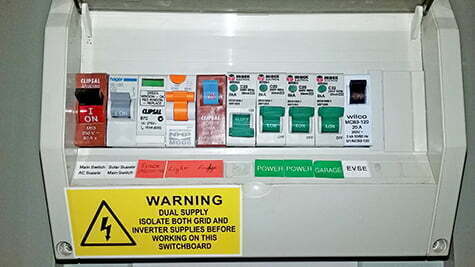

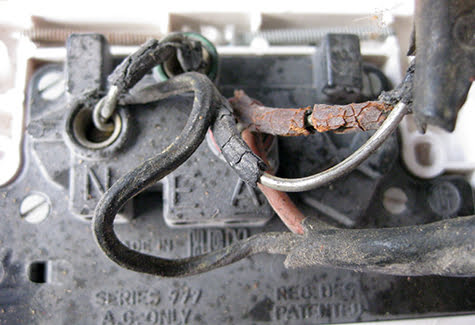
2. Choosing your EVSE charging mode and current
Figure 1 shows the different EVSE charging modes. Only Modes 2 and 3 apply to commercial EVs in Australia when charging at home (Mode 1 is for converted EVs and Mode 4 is for charging stations). Mode 2 EVSEs are commonly called portable as the cable includes the control box; there’s no fixed EVSE on the wall. They require a 15 A outlet. Mode 3 EVSEs have a fixed control box on the wall and come in 16 A or 32 A, single- or three-phase versions.
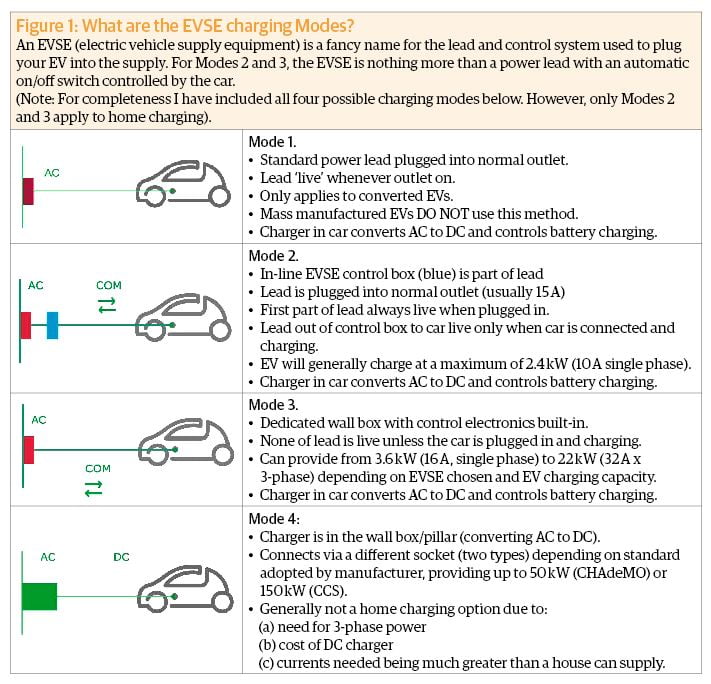
If your current household switchboard and supply is capable of supporting a 32 A (7.2 kW) Mode 3 EVSE, then you may as well install one. They generally cost just $100 to $200 more than a 16 A (3.6 kW) one. A 32 A EVSE will provide some futureproofing for later (higher battery capacity) EV purchases or the faster speed will enable you to charge two EVs overnight (one at a time).
If you only have capacity to install a 16 A Mode 3 EVSE without significant upgrade costs, it is worth asking yourself whether you really need 32 A yet. All EVs will still charge at 16 A, if a bit slower. Older EVs in Australia like the Leaf and iMiEV charge at a maximum of 16 A anyway. As you can see from Table 2, if you plan to only overnight charge, then 16 A is probably all you will need.
If you are constrained by the costs of upgrading the household wiring and supply, consider if a Mode 2 (15 A outlet) will be enough. Most homes have enough capacity to install one of these. Yes, it will be slower even than a 16 A Mode 3 EVSE, as such EVSEs are generally throttled back to 10 A/2.4 kW, but will the charging speed increase be worth an extra $10,000?
A Mode 2 EVSE is the cheapest option, and is still the most common option chosen by current owners of EVs with shorter range batteries. The disadvantage is that, as there’s no fixed control box, you have to pack it up to take with you after each charge. The control box takes a battering because it is always being moved around. Some EV owners buy a second Mode 2 EVSE for home use (costing from $600 up) and keep the original manufacturer’s unit in the boot for emergencies. Another issue is that for the new crop of longer-range EVs, should you want to do a full charge from empty, Mode 2 charging cannot fully charge the EV overnight (see Table 2). However, given the longer range of these EVs, a full charge is unlikely to be necessary for most travel needs.
3. Where to position the EVSE?
You have now decided that you can install an EVSE and which type; but where is the best place to put it?
Note that this article deals with homes that have off-street parking. The intricacies of charging EVs in situations such as townhouses and flats where the EVSE cannot be easily connected to your switchboard or where off-street parking is not available will be dealt with in a later issue of Renew magazine.
Charging is best done in an area not exposed to extremes of weather or temperature (see ‘Keeping your EV battery healthy’ in Renew 139). If you park the car under a carport or in a garage where it is protected from rain and sun, this is the best place to charge it.
If the car is parked outdoors, then you may need to consider the times you plan to charge it. If you are intending to charge mainly during the day, try not to pick a spot in full sun in summer. If you will be charging overnight only, somewhere slightly sheltered from extreme cold or the prevailing rain direction is best.
If you have little choice in where the car is parked, that’s okay, but it will influence some charging times, as well as limit the choices in EVSE according to their weatherproof rating.
4. What EVSE to buy?
You have now decided on which charging mode (Mode 2 or 3) you want and the position of the EVSE. If choosing Mode 3, you’ve also decided on the current (16 A or 32 A), according to your requirements for charging speed and the electrical upgrade costs. Your last step is to choose the EVSE itself.
For Mode 3, there are additional considerations, including the lead type (tethered or BYO) and the socket/plug type (J1772 or Mennekes).
As noted in the article ‘Plug wars’ in Renew 141, the best choice for new Mode 3 EVSEs is a Mennekes socket with a BYO lead (where the EVSE itself doesn’t have a tethered lead). Most new EVs will use the Mennekes socket standard. If you are buying a new Japanese (or an older) EV with a J1772 car socket, you will need to buy a conversion lead to connect the Mennekes wall socket to your J1772 car socket.
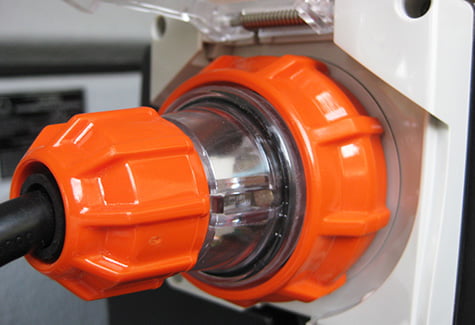
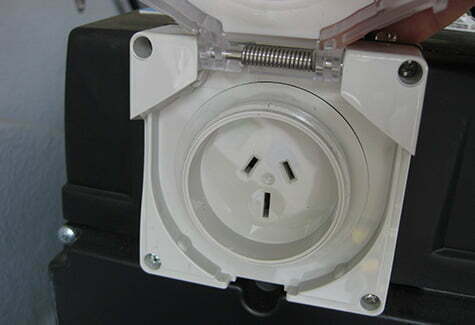
The move is also towards BYO leads for public Mode 3 EVSEs—this is more secure for public charging stations and will become the norm with the new crop of Mode 3 EVSEs available for purchase.
Also consider if you need smart options. For example, the Zappi EVSE acts like a regular Mode 3 EVSE but has datalogging and three charging modes, including eco+ that allows you to charge your EV using only the spare energy available from your PV system.
For those with three-phase power, you’ll also have a choice of single- or three-phase. As Mennekes is a three-phase standard, all Mennekes EVSEs should automatically be able to be connected to single- or three-phase, but check this is the case for your specific choice before buying!
Buyers of a Zoe who want to access Mode 2 charging will need to buy an aftermarket EVSE for this. At the time of writing, Renault do not supply one with the car.
For both Mode 2 and Mode 3, you’ll also need to consider the IP (international protection) rating of the EVSE:
- If the EVSE will be indoors, any Mode 2 (15A outlet) or Mode 3 (fixed wall box) will be fine. It does not need to be rated for outdoor use.
- If the position is outdoors, but sheltered by a carport or similar, then you will need to provide the EVSE with some form of adequate shelter from rain and dust, or choose one that has an IP rating. IP53 would be a good minimum. Your installing electrician will guide you as to the exact IP rating needed.
- If the position is fully exposed to the weather, you will need the maximum IP rating. For Mode 2 outlets, a screwed outlet (like the one pictured above) is recommended. This provides IP66. For a wall-mounted Mode 3 EVSE, IP65 is needed, but not many Mode 3 EVSEs on the market have this rating.
In conclusion
Home EV charging options are not as simple as ‘just install the highest capacity EVSE my car can take’. What EV charging system you install is determined by your budget, your EV charging speed needs and your household supply capacity. However, installing the right EVSE for you in a well-located charging spot makes the ownership of an EV just that much nicer—and far more convenient than making the time for finding, queuing and paying randomly fluctuating fuel prices at a petrol station!
This article was first published in Issue 143 (Apr-Jun 2018) of Renew magazine. Issue 143 is our building materials special, including a window buyers guide and an article on flooring options.
Recent articles
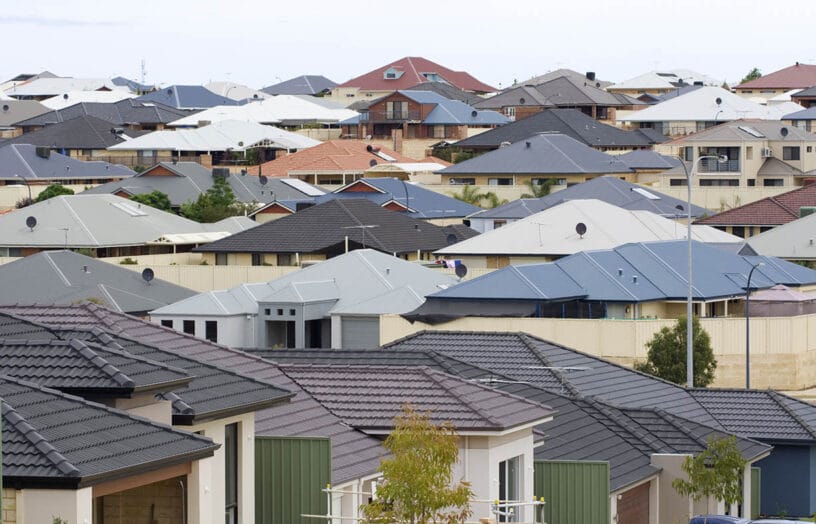 All-electric
All-electric
Mandatory disclosure of energy ratings on the horizon
Graham Hunt introduces us to a soon-to-be-implemented national framework that will be a massive win for renters and homebuyers.
Read more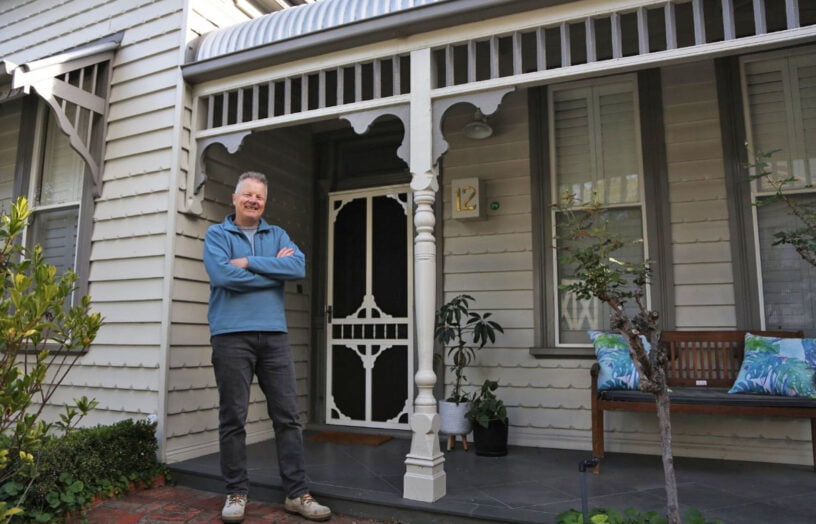 All-electric
All-electric
A gas-to-all-electric and EV retrospective in data
Peter Hormann's household has invested in energy efficiency and converted from gas-electric to all-electric for their 1908 Edwardian home in Melbourne. So what can be learnt from the last 8 years through data? What might have happened otherwise?
Read more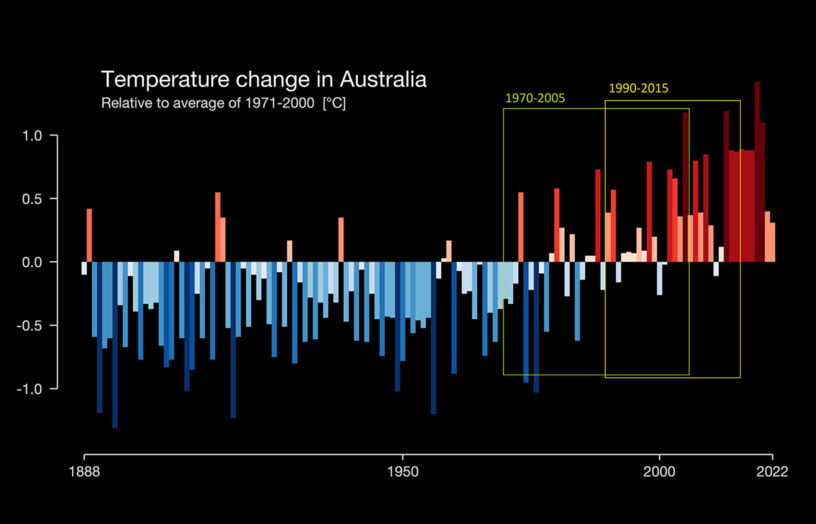 Efficient homes
Efficient homes
Building for a changing climate
Are we building homes for the future, or for the past? Rob McLeod investigates how climate change is impacting home energy ratings and the way we build our homes.
Read more

